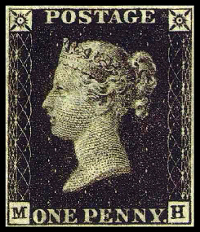The Art of Stamp Collecting
Few hobbies are as widespread as stamp collecting. There's a huge variety of stamps, and it is a relatively inexpensive collectable, making it accessible to anyone.
The first stamp and the start of stamp collecting

The first postage stamp, the Penny Black, was issued by Britain in 1840 and pictured a young Queen Victoria. It was produced without perforations (imperforate) and consequently had to be cut from the sheet with scissors in order to be used. While unused examples of the "Penny Black" are quite scarce, used examples are quite common, and may be purchased for $20 to $200, depending upon condition.
As soon as the 1860s, children were drawn to growing range of postage stamps in production, and stamp collecting was born. As those children grew into adults, they continued stamp collecting, thereby making it common hobby for adults. By the inter-war years, stamp collecting had taken a firm position as one of the most popular hobbies in the United States. The hobby has continued to be popular for both children and adults alike well into the 21st century.
Types of stamp collections
One of the great things about stamp collecting is that there is such a wide array of postage stamps and similar items available, which means that there can be countless different types of stamp collections. Whatever your personal interest, be it animals, Americana, cartoon characters, sports, or even Elvis, you will find stamps from all over the world just waiting to be collected. Stamp collecting is not just limited to postage stamps, either. Oddly enough, Federal Duck Stamps are one of the most popular and well-known collectible stamp series. Other stamp types that are popular include souvenir sheets, postal stationary.

Beginning a Stamp Collection
To start collecting stamps on a casual basis, start looking at your mail as it comes in and keep the ones you find interesting or beautiful. After a while, you should get an idea about what kind of collection you want. Once you have a basic idea of where you want your collection to go at first (and keeping in mind that it is always easy to expand or change the focus of your collection) it is time to invest in some proper tools. Of course, if you are on a tight budget, stamp collecting can be done on the cheap. But for best results you should get some clear plastic sleeves and a notebook to store your stamps in a manner that protects their condition and keeps them safe from the elements. You should also think about investing in other specialized tools, including specially designed stamp tongs. These tongs prevent skin oils from coming into contact with the stamp, which will further promote sustainability in the stamp.
How do you get stamps?
Your first and best resource for stamps will be your friends and family. Let them know you are a collector, and have them send the stamps they receive over to you, they will likely be happy to save the stamps from their incoming mail for you to look over and select from. There are also products where companies send out a selection of stamps for the collector to look over. Generally, these programs allow the collection to keep the stamps for up to a month without charge. After a month's time, the collector can choose to purchase the stamps that are of interest, and return those that do not fit into their collection. Just remember to return the stamps you do not want on time!